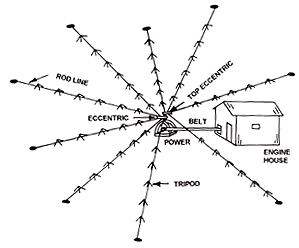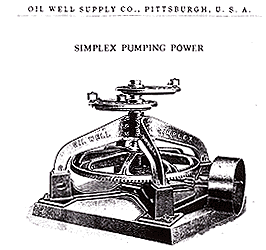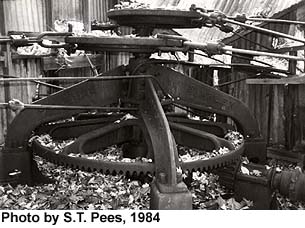 |
||||||
THE CENTRAL POWER
 |
||
A Pumping OilfieldWalking into an oilfield that is being pumped by a central power, is like an obstacle course. Rod lines are seemingly suspended everywhere and tripods, pipes, pump jacks, other devices and the massive power itself fill the oilscape. This section of oilhistory.com is devoted to the behemoth of pumps called the central power. The principal components of this early method of pumping multiple wells will be discussed and pictured. To the author, the remains of a central power and its pumping array are the most interesting of the major artifacts to be found in the shallow oil region. A schematic drawing (above) is necessary to give the reader an idea of the layout of a power. The word power, in oilfield parlance, stands for the gears and eccentrics, the engine, the whole caboodle. One is supposed to know exactly what the pumper is talking about when he says power. Actually the power is the heavy iron contraption in the center of the drawing, but it wouldn't pump oil without the engine, the belt, the tripods, the rod lines, the jacks and the wells. The building is part of the power too. The above drawing, of course, is schematic. It is an array of wells being pumped by a central power. Many more wells than shown could be pumped by the two eccentrics on the power. Each eccentric has 18 holes to which rod lines can be fastened. Some installations have the powers mounted in the same building with the engine. The rod lines would then come out through holes in the walls. The eccentric is really the essential element of the power. You probably think of something odd or behaving in a strange way when you read or hear the word eccentric. Actually, the eccentric in a power is, in fact, odd. It is fixed out of center to a revolving shaft. This allows it to convert circular into reciprocating rectilinear motion. Although I am very accustomed to seeing these things, at rest or at work, I have difficulty in making a definition "come alive." In describing the motion of an eccentric, geoscientist Keith H. Patton offers the following analogy: "— you might use the analogy of a bicycle pedal and sprocket lying on its side with the rod connected to the pedal. I think that will give a mental image of how circular motion can be converted into linear reciprocating motion." |
||
|
||
|
![]()
| © 2004, Samuel T. Pees all rights reserved |
|

